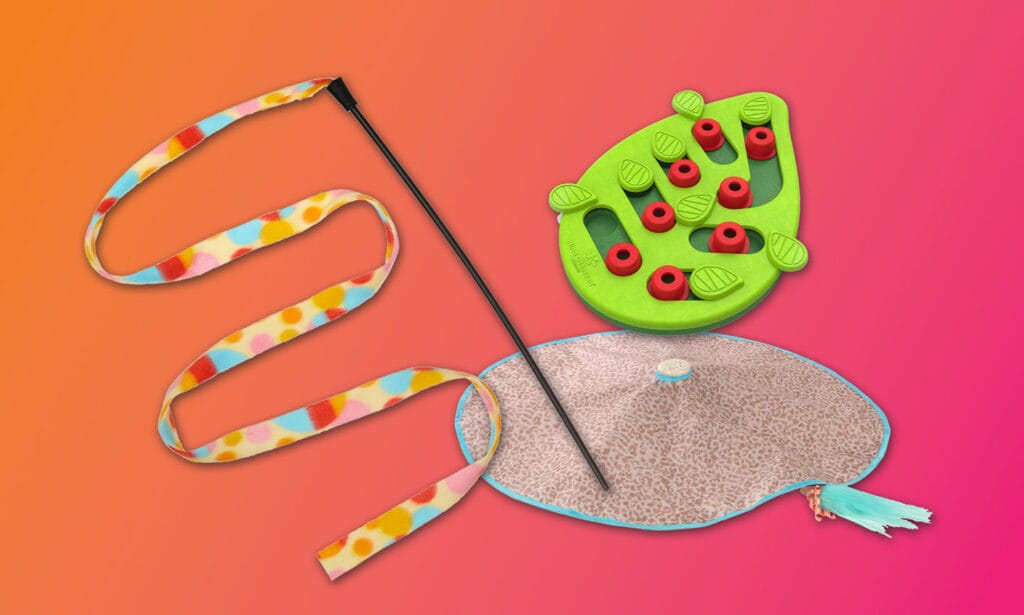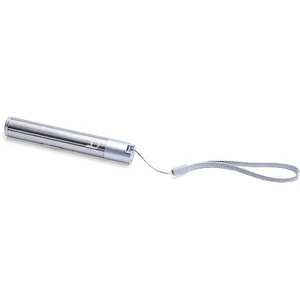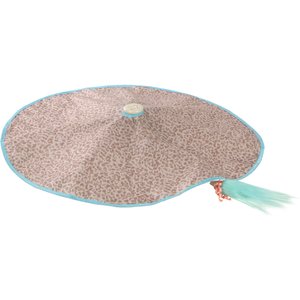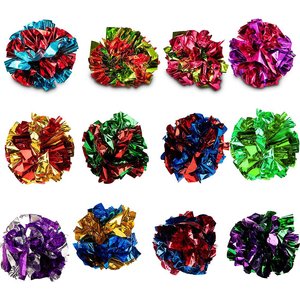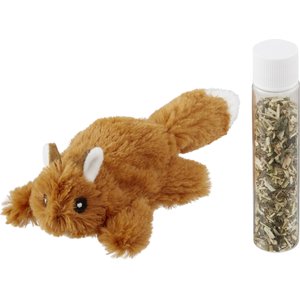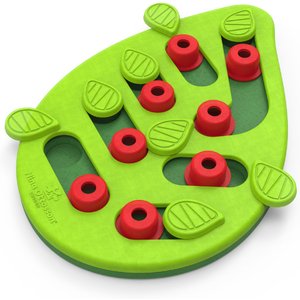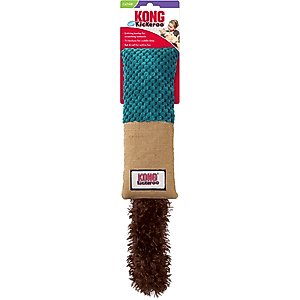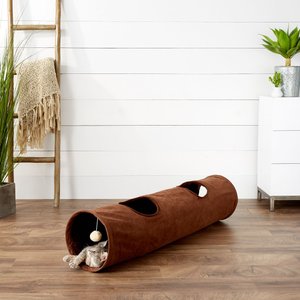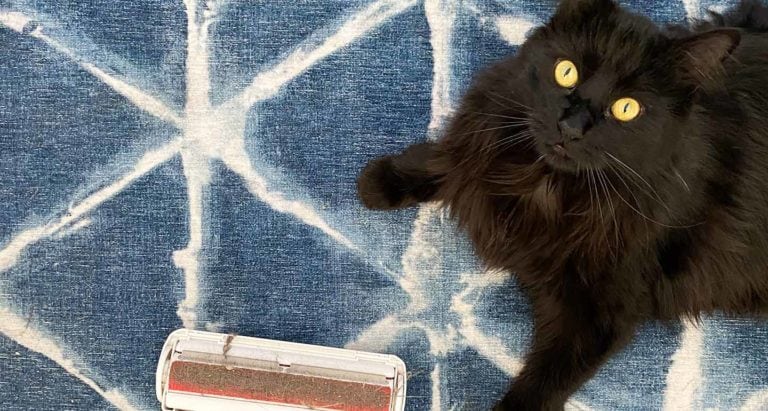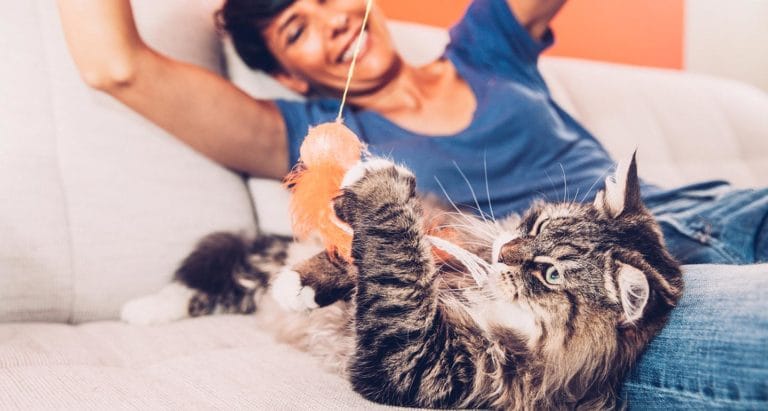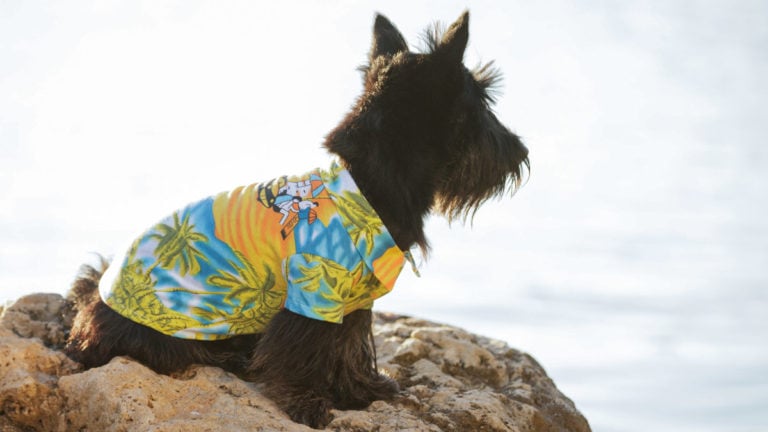We’ve all been there. You buy your cat a nice, fancy toy, and then... you catch them playing with a random piece of plastic instead. Why bother at all?
There are many reasons to offer your cat a toy. And not just one, but a variety of toys.
Toys provide your cat with mental stimulation, physical exertion, and opportunities for bonding with you through playtime. Toys in your home actually create a more natural environment for your cat—similar to what they would experience in the wild.
“It's a much more natural lifestyle when they're engaging with toys and engaging with their environment,” says Sandra Mitchell, DVM, a traveling veterinarian and owner of All Creatures Veterinary Services based near Bangor, Maine. “Especially if you have the right toys that mimic the natural behaviors of cats—hunting, clawing things, stalking, food acquisition, and all those.”
So what are the right toys? There are teasers, puzzles, balls, and lasers, to name a few. How do you choose?
To help you find the best toys for your cat, we tested 31 of Chewy’s top-rated toys in real-world conditions. We rated each toy on the following attributes: engagement level, safety, design, and value.
The toys on this list are considered stimulating, safe (when used properly), well made with smart features, and all for a reasonable price.
- 1
- 2
- 3
- 4
-
5
Best Puzzle Cat ToyNina Ottosson® by Outward Hound® Buggin' Out Puzzle & Play® Cat Toy $19 on Chewy
Best Cat Laser Toy
Pet parents with cats who can’t resist the allure of the red dot, look no farther than this 3-in-1 laser pointer. There’s a lot to like about the little interactive cat toy, from its multi-purpose use to its built-in USB connector for easy charging.
It has three settings: laser, flashlight, and UV black light. The red laser is vibrant and can project a bright dot up to 100 feet away, as advertised. (I had to go outside to test that far of a distance, but it worked.)
It sent my cat, Luna, into full-on hunt mode. I loved watching her get low to the ground and zigzag across the room, trying to snuff out the dot with both paws.
The flashlight is about what you would expect from a keychain flashlight. It’s good in a pinch.
The black light is used to detect stains, like urine. It’s not a must-have for me, but it’s nice to know it’s there if needed.
To select a lighting option, you slide the on button to the desired setting and then release. This makes playing with your cat easier because you don't have to press down on the button the whole time, as with some other laser pointers. (Do not shine it into their eyes!)
I have not needed to recharge it yet, but I tried out the charging ability and it was quick and easy. Instead of a USB cable, it has a built-in USB connector (similar to a flash drive) that you can insert into any USB port to charge.
It does not come with a USB port to plug the connector into, but those are so ubiquitous these days it wasn't a problem for me.
We have an outlet in the kitchen that has a USB port built in, and that’s what I used to charge it. You could also use your cellphone’s charger block or laptop’s USB port, or you can buy a cheap one at a convenience or big box store.
The price is at the upper end of what these cat laser toys cost, but I think it’s worth it due to all the features. Luna wishes your cats happy hunting!
Things To Consider:
• Three lighting modes: laser, flashlight, and UV black light
• Bright red laser dot shines up to 100 feet
• Don't have to hold button to keep it turned on
• Built-in USB connector, but no port provided
-
Cat and daughter love it!
My daughter loves to play with her cat! Best of all the laser pointer is rechargeable. Say no to batteries :)
-
Worth it!
My cat loves this thing and it's super easy to charge up. I love that it's a switch so you don’t have to hold down on a button to control the light
-
Fun time for Molly
Molly loves chasing the little red bug. We play every night and she loves racing down the hallway after it. So cute to see her having so much fun. Glad I bought this.
Best Electronic Cat Toy
There are many different forms of electronic toys, from battery-operated fish that flop to motion-activated lasers. This automatic cat toy scored big for its ability to engage our kitty tester, Serendipity (aka Dip).
“It’s extremely mentally enriching, and a fantastic outlet for [cats’] instincts,” says Casey Seleman, Dip’s cat mom and veterinary technician.
It mimics the motions and sounds of prey hidden under brush in the wild by swinging a furry teaser toy back and forth under crinkly fabric.
“Dip’s favorite game has always gone like this: I put my hand under a blanket and move my fingers in and out from beneath it,” Seleman says. “This toy effectively replicates her favorite game!”
Powered by AA batteries, it features three speeds (slow, medium, and fast) and a “random” setting that alternates speeds. The slow speed was surprisingly fast and more than enough for Dip.
“She needed to take breaks often. I think she becomes overwhelmed a bit,” Seleman says.
Seleman also notes that the loud sound of the wand dragging across a hard surface floor could scare some cats. She recommends using it on carpet, at least initially, to muffle the sound.
Things To Consider:
• Automatic toy mimics motion and sounds of wild prey
• Requires three AA batteries (not included)
• Three speeds, though slowest speed may be all that your cat needs
• Noisy on hard surface flooring
-
The cat plays.
I adopted a special needs cat from a shelter and was told she doesn't play. She does play and she loves this. She's always asking me to turn it on. I really like the fact it shuts itself off after a few minutes if the cat stops playing.
-
Fun Times
Recommend!!! My 7 year old cat loves! Keeps him active. He is a big boy at 17 pounds and this toy is holding up to his vigorous play!
-
From terrified to loving it!
This is the first interactive toy Holly would ever play with. The interactive fish terrified her. This stimulates Holly's mind and her physical prowess. She absolutely loves it!!! I expect the Vet to tell me she has lost some of her chubby!
Best Cat Ball Toy
Ball toys come in an array of materials, including plastic, rubber, foam, and fleece. Chewy Editor Claudia Guthrie found these balls made of lightweight mylar to be the best after a week’s worth of daily play with her cat, John Wick.
What makes them a real standout? Their cat-addicting crinkling sound, which Guthrie describes as a “little playtime alarm bell.”
“I don't know what it is about the sound of the crinkling, but my cat went crazy for it,” she says. “I would pick up a ball, crinkle it, and he would instantly drop low, ready to pounce.”
She appreciates that, unlike plastic balls with actual bells, "these won't break when I inevitably end up stepping on it.” They also do not contain any small parts or strings that can become dislodged and accidentally swallowed.
Another plus was the price: You get a dozen for around $5.
Guthrie highly recommends them for cats who like to bat toy balls around versus those who like to roll balls around and chase after them.
And because the toys are so lightweight, they don't travel very far when you throw them.
Things To Consider:
• Addictive crinkle sound
• Lightweight design better for batting around vs. throwing/tossing
• Won’t break when stepped on
-
my siamesey stray LOVES these
One of our cats is vaguely Siamese and he has a lot of inquisitiveness and loves unusual experiences. Regular balls and bird type toys don’t do much for him, but he goes bananas for these. Carries them all over the house like they’re his friends. Even takes them to the toilet with him. Will be buying again once he’s thrown all of these deep under the fridge by mistake.
-
Hours of entertainment for my Bengal
One of my cats loves these. The others are not interested. The each have their favorites, but these keep the Bengal entertained.
-
My kitten loves these toys!
She comes running whenever I open the drawer where they are stored or rustle the ball. My other cat is less thrilled but still plays with them.
Best Cat Plush Toy
Dogs may be more well-known for chasing after squirrels, but cats can get in on the hunt, too, with this squirrel plush toy from Frisco by Chewy®.
Tester LeeAnna Buis, a certified feline training and behavior consultant, appreciates its well-made construction and the little pouch for filling with catnip.
“The refillable catnip makes it easy to ‘recharge’ and spark your cat's interest,” says Buis, though pet parents should take care not to let the catnip cover the hook-and-loop closure when pouring it in, as it makes the fasteners less secure.
Cat tester Ollie especially loved when his mom rubbed the toy on his face.
At about 6 inches in length from nose to end of tail, it was too small for “bunny kicks,” which is Ollie’s preferred method of play, but the smaller size makes it easier for cats to carry around.
“It's a good size for the ‘post-hunt, strut around and show off your kill,’” Buis says.
Things To Consider:
• Small size ideal for treating like prey
• Refillable compartment for catnip (included in purchase)
• Well-made construction
-
Makes My Cats Posessive
We bought one of these toys which our cats instantly fell in love with. They’ll use it as a kicker toy, and one of our cats will pick it up by the ears and fling it around. The only downside is our cats like it so much, they’ll both want to use it at the same time. Even when no one’s using it, our orange cat will walk up to play and suddenly the tabby comes to bite his ears and claim it for herself. Would it be better if we had two? Who knows with these cats.
-
My cats stole this from the kitchen counter and got it out of the packaging
My cats stole this from the kitchen counter and got it out of the packaging - they liked it that much!
-
My cat LOVES toy
She can't get enough of this toy once I filled it with catnip! She rolls around with it all the time and thoroughly enjoys it! :)
Best Puzzle Cat Toy
Puzzle toys provide good mental enrichment for cats, especially those who are food motivated.
This one was a clear winner for our tester, whose three senior cats were easily able to move the puzzle pieces around to find their hidden bounty.
It features adorable ladybug-like pegs that slide and leaves that swivel. Cats move those pieces to uncover treats(sold separately). Treats also can be placed inside the pegs to be fished out, creating a more challenging game.
“The pieces of the toy are pretty easy to move with paws,” says tester Marci Koski, a certified feline behavior and training consultant. “My cats had no problem scooting the leaves and bugs around to get at the treats.”
Once the treats were uncovered, actually getting them out of the little cups presented another challenge. “Perhaps if they were scoop-bottomed, they would be easier for kitty paws to get treats from,” she says.
Still, that did not hinder her highly food-motivated cats, Oliver, Samantha, and Momo.
“Oliver figured out that he could just stick his face over the cup and lick the treats out,” Koski says.
The cute nature-inspired design also won Koski over, as did the puzzle’s quality construction for the price.
“[It] will bring lots of enjoyment to my cats for weeks to come,” she says.
Things To Consider:
• Recommended for food-motivated cats
• Puzzle pieces are easy for cats to move
• Adjustable for more challenging play
• Large enough for multiple cats to play at once
• No removable parts for safer play
• Clean with warm running water and soap (dishwasher not recommended)
-
Provides entertainment for us too
I was worried this would be a bust, my cat is 12 years old and has eyelid agenesis so her eyesight is not great and in general she doesn't show much interest in toys or other cat puzzles we've gotten. Well, it was a hit! It took a couple of weeks to figure it out and now she loves it. We keep it on the floor and she likes batting the little lady bugs around even when the treats are gone!
-
Fun way to give treats!
I got this for my cats and it took them different amounts of time to figure out how to get to the treats - but they have all figured it out! It makes them work for their treats a bit and keeps them interested for quite some time! Highly recommend giving it a try with your cats!
-
Slows down a forever hungry cat
I have never seen the end of my cat's hunger. He eats very quickly is disruptive when I am eating as well. This toy has been a savior - forcing him to eat slower and keeping him occupied when it's my meal time. My boy is full-grown and has a large head but is able to get to the food.
Best Kicker Cat Toy
Our tester cat Winnie got a real kick out of this kicker toy from KONG, which features multiple textures, including burlap, soft velvet-like plush, and a fuzzy tail. Catnip and crinkle sounds add to the excitement.
At 9.5 inches in length (16 inches if you include the tail), this stuffed toy is long enough for cats to grab with their front claws and bunny kick it with their hind legs, which is exactly how Winnie likes to play with this toy.
She also likes chewing the soft tail and rubbing her face on the toy because of the catnip inside, reports cat mom Guthrie.
The multiple ways for cats to engage with this toy was a plus, especially since Winnie is a “really high-energy cat and demands a lot of playtime,” Guthrie says.
In addition to independent play, Guthrie notes that pet parents can wave it around and make the tail wiggle to encourage interactive playtime together.
Despite lots of wrestling action, the kicker toy has held up well and there are no safety concerns over any pieces coming loose.
Overall, Guthrie describes it as an affordable, simple-yet-effective cat kicker toy.
Things To Consider:
• Multiple features entice multiple types of play
• No squeaker makes it a fairly quiet toy
• Large size allows cats to get a good grip, but takes up more space in toy box
-
Kicker toy
My cat loves this toy. She kicks away at it and loves the furry end as well. She keeps it on her perch with her.
-
Best toy my cat ever had!!!
My cat hasn’t left this toy alone since he got it 3 days ago! He has never played with a toy like that ever before! Usually it’s 5 minutes and on to something else!
-
Cats love
This is my cats favorite toy. We know own 3. Out of all the toys this is still there favorite.
Best Cat Wand Toy
Cat wand toys help engage your cat’s inner hunter, and this one brought out the wildcat in our kitty testers.
It immediately captured cats Oliver and Momo’s interest when cat mom Koski waved it around to initiate playtime.
Koski was especially impressed with the ribbon’s fleece fabric, which was very stretchy and allowed her cats to get a good grip on it.
“It's so soft and stretchy, and easy to catch and ‘keep,’” she says, noting that wands should be kept out of reach when not in use, because cats could become tangled up in the string and potentially injured.
This one, she says, is small enough to easily be stowed away when playtime is over.
The handle of the wand was a little on the long side, which offers limited control, and Koski’s cats’ interest began to wane over the course of the weeklong testing period (as is common with cats), but it's a good value for the price and makes a great toy to swap in and out of rotation.
Things To Consider:
• Simple toy that packs a lot of punch
• Soft fleece ribbon is engaging and easy to catch
• Longer handle limits amount of control
• No small pieces to cause a safety hazard but should be kept out of reach when not being used to prevent tangles and/or injuries
-
Cats love this one!
Both my cats love this teaser wand toy. Hard to find one the 9yo will go crazy for, and the 3yo loves it too! The weight at the end of the wand makes it easy to spin the fabric around.
-
My cats love this toy
My cats love to play with the fabric wand toy as I swirl it on the floor they race to catch it. If I want to be lazy I can stand at the bottom of the stairs and twirl it/whip it up quite a few stairs and they go crazy running up and down the stairs chasing it. A great way to get all that energy out before bedtime.
-
Simple but great
Really not much to this, but it's my cats favorite toy. The piece of fabric is a lot longer than many of these types of toys so it's got a good amount of flutter when you wave it around; the cats are always interested in playtime as soon as I pick this one up.
Best Cat Tunnel
Made from a lightweight flexible frame covered in a soft suede-like material that makes an enticing crinkling sound when touched, this cat tunnel features a dangly toy at one end and two holes or “windows” on the side.
It provides various forms of enrichment for my cat, Luna. She likes to sprint through it, loaf in it, and sleep in it.
She also enjoys it when she’s inside and I dangle wand toys into one of the windows or just outside one of the openings on either end.
At 47-inches long, it allows cats to fully hide within the tunnel without sticking out, as may be the case with shorter tunnels. I think that’s why Luna likes it so much—because she can be completely concealed from the outside world.
I could see this being a good size for multi-cat households too.
The straight tube shape is another selling point. Luna likes to blast through it during zoomies, and the straight shot makes it easy for her to do just that.
Being a straight tube also makes it easy to push it out of the way against a wall, dresser, or other piece of furniture.
It is collapsible and has toggle buttons to keep it tightly secured for easy storage. But, since this has become one of Luna's favorite toys, we keep it out 24/7. Being able to push it up against the wall to get it out of the way is ideal.
I could do with a different color other than brown, maybe something that suits our home decor better, but at least it blends in with the hardwood floors.
Things To Consider:
• Straight tube shape is great for cats to run through and easy to push out of the way
• Folds up for easier storage if you want it totally out of the way
• Length allows a cat to fully fit inside, would also fit multiple cats
• More color options would be nice but not a deal-breaker
-
Takes Playtime to Another Level
My cat is extremely playful and when we adopted her, I noticed she seemed to want to crawl inside things during playtime. I waited a few months and got this and oh my gosh- she loves it so much. She's a big fan of the crinkle noise, so she will something just punch on the tunnel itself, but most of the time, she just loves to play in it, and hide in it when she's planning to attack her helpless burrito toy. If she ever wears this one out, I will definitely be buying another.
-
Crinkle noise and durability of the tunnel
This is a favorite of the cat and the dog. They play hide and seek in it, with the dog peeping in the side holes looking for the cat to rustle through it.
-
my cat is OBSESSED
idk why but my little ragdoll loves this so much. he'll sneak in here & even take naps sometimes. he loves peeking out of all the tunnels & pouncing on the little pompom at the end. a little noisy with the crinkling but my cat obviously loves it so its ok
Best Ball Track Toy
What makes the Frisco Scratch & Roll Cat Toy the best? It’s a twofer! Cats get both an exciting ball track toy and a corrugated cardboard pad to satisfy their scratching needs.
Luna loves scratching cardboard, so this was right up her alley, immediately sparking her interest—no catnip required, even though it does come with a little packet of ’nip.
And one of the best parts is that this toy comes fully assembled so all I needed to do was take it out of the box to let the fun begin.
Luna's style of playing with ball track toys is to lie on the floor and lazily bat the ball back and forth, and I appreciate that this one has little peepholes on the side of the base through which to see the ball. While the holes could be larger, it was a plus to have them at all.
I also like that the design of the track ensures the ball does not pop out if playtime gets rowdy.
The scratcher was what really sold me on this, though. It has now become her favorite scratch pad in the house.
Luna still scratches it every day and, because it is quite large (almost 10 inches in diameter), she even likes to lounge on it—which has earned this toy a permanent place on our living room floor.
Things To Consider:
• Dual use with ball track and scratcher
• Ready to go right out of the box
• Comes with catnip to entice play
• Toy can be played with from the top or the side thanks to (small) peepholes
-
High quality
Love this! The color is amazing and the material is durable. I accidentally bought the replacement pads for a different toy that was bigger, but I managed to fit it in once I stripped some layers off of the cardboard.
-
My cat's love it!!
My cat's really love to play with this toy I need to order more of the scratch boards cuz I noticed that each of the cat's nails are in there so it also helps groom their nails.
-
Awesome cat scratcher
My cat needs to scratch-she loves this and the furniture stays scratch free! My pup does try to get the ball out of it, tho :)
Best Cat Chew Toy
Satisfy cats' chewing desires with this top-rated cat chew toy from Catstages. It earned top marks from our tester, Buis, for its smart and safety-conscious design.
The durable netting is meant to help remove tarter from teeth when cats bite into it, and it’s stuffed with catmint, a cousin of catnip, to both entice cats and freshen breath.
Buis says the smaller size (about 5 inches long) was very manageable for her cat Ollie to play with, and she likes the softness, which limits the chances of it getting stuck or wedged in the jaw.
She also appreciates that it doesn't have any small pieces that can be chewed off and swallowed.
“Being fabric, there is some danger of a cat pulling it apart and ingesting bits, but it seems well-made,” she says, adding that cats should always be supervised when playing with chew toys.
The catmint filling was a hit, piquing Ollie's interest. Buis reports that he especially enjoyed rubbing his face all over the toy, “which was adorable.”
Given the cost, construction, and various features, Buis thinks it’s a good value, and recommends it to pet parents whose cats like chewing fabric.
Things To Consider:
• Ideal for cats who like chewing fabric/soft materials
• Durable netting offers dental benefits
• Catmint entices and freshens breath
-
LOVE THIS!
All my cats like this...I've purchased at least 3 of them. I even leave the old ones out and they still lick on it and play with it!
-
One of my cat's absolute favorites
At this point, I think I've bought this at least 5 of these. My cat loves to chew these to pieces, which I can't complain about because they're cheap and they make her breath smell good. When she's not shredding them, she also loves to fling these around and play fetch. They very easily get stuck under the fridge, though.
-
10/10 would recommend
My house loved them. My cats are not really into catnip, but these were really good for them and I noticed their teeth were really good as well. I have two cats and they both played with it. It lasted a day in my house cause they loved it so much.
What To Consider When Buying a Cat Toy
Potential for Engagement
Toys can help engage cats both mentally and physically. Whether your cat will find the toy stimulating will depend on how your cat likes to play.
Some cats like independent play. Mice, kickers, and plush toys are all things they can attack and play with on their own.
Some prefer moving toys, whether moved manually by you or automated. Things like wands, ball tracks, or lasers could suit such cats.
“It depends on the personality and some degree of trial and error,” Dr. Mitchell says.
Safety
The last thing any pet parent wants is for playtime to turn into a medical emergency. Dr. Mitchell says to be on the lookout for the following hazards:
- Toys or pieces of a toy that are small enough to be swallowed. Those could cause choking or, if actually swallowed, an obstruction in the GI tract.
- Anything that’s string-like. The string could become wrapped around a body part or swallowed and cause injury.
Such toys “should be for supervised play only or ‘no-no’ toys,” Dr. Mitchell says.
Design
Make sure the toy is designed to function the way you want your cat to play with it.
For example, if you want a ball toy that you can roll on the floor and have your cat chase it Tokyo-drift style, opt for one made from harder material, like rubber or plastic. Those are much more effective at rolling than a softer, plush-like ball, which is better for playing fetch, as your cat will be able to sink their teeth into it and carry it back to you.
If you plan to purchase a treat-dispensing toy, make sure the holes are big enough to allow the treat you intend to use to actually come out.
When picking a plush toy, ask yourself if you want it with or without a squeaker. Some plush toys also contain catnip to entice play. Could your cat use the extra incentives?
Aesthetics matter too. Because cat toys come in so many shapes, styles, and colors, it’s a great opportunity to show off your cat’s personality and yours. Or maybe you want something that blends in with your home’s decor. After all, it will likely be strewn about your home all day, every day.
Value
Prices vary across cat toys, and you want to make sure you’re getting your money’s worth. You can get little hunting/chasing toys, like balls and mice, for a few bucks. These types of toys tend to take a beating and can get lost easily. If they do start falling apart or go missing, it’s not a huge financial loss.
Puzzles and electronic toys, on the other hand, tend to cost more. With a higher price tag, it’s not uncommon to expect a higher level of craftsmanship and durability.
How We Tested
We started with 31 of Chewy’s best-selling cat toys that came highly rated by Chewy customers—the ones cat parents like you love the most.
Each toy was tested for at least one week. During the trial period, the pet parents were asked to initiate playtime daily with their cats and the toy, and the cats were free to play with the toys independently.
The pet parents then rated the toys on the above attributes. They also took notes on their experience and filled out a questionnaire.
Testers included:
- Dr. Marci L. Koski, CFTBS, CFTPB: Koski is a certified feline behavior and training consultant at Feline Behavior Solutions in Vancouver, Washington. She tested cat toys with her domestic shorthair cats, Samantha, 16; Momo, 15; and Oliver, 15.

The Buggin’ Out cat puzzle toy is large enough for Samantha, Momo, and Oliver to play all at once. Photo courtesy of Marci Koski.
- LeeAnna Buis, CFTBS, FFCP: Buis is a certified feline behavior and training consultant at Feline Behavior Solutions in the Seattle area. She tested cat toys with her cat 6-year-old black cat, Ollie.
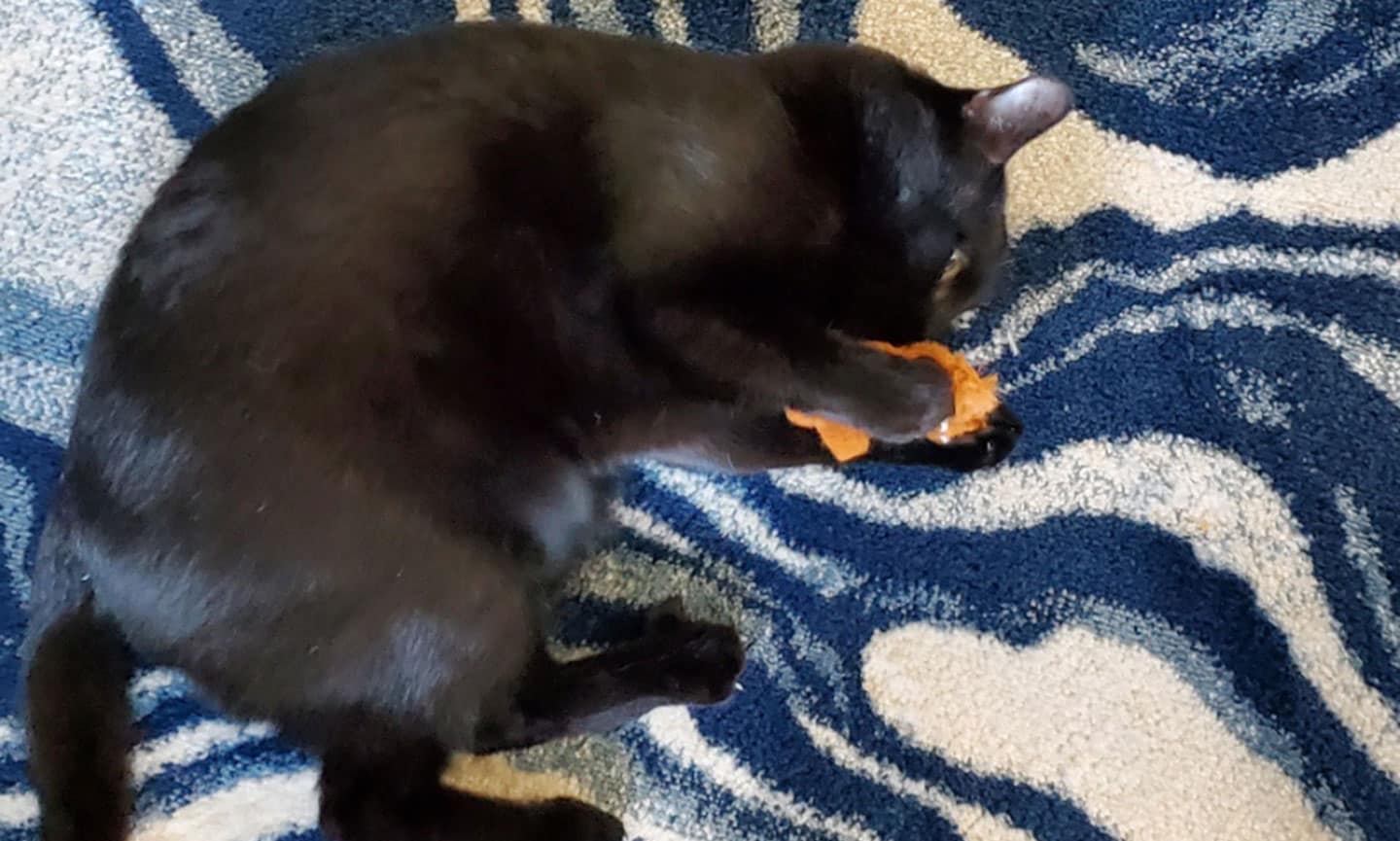
Ollie gets up close and personal with the Frisco Squirrel plush toy. Photo courtesy of LeeAnna Buis.
- Casey Seleman: Seleman is a veterinary technician at Woodstock Animal Hospital in Woodstock, New York. She tested cat toys with her 9-year-old cat, Serendipity, or Dip for short.

Dip chases after the SmartyKat Instincts Hidden Hijinks Electronic Cat Toy. Photo courtesy of Casey Seleman.
- Claudia Guthrie: Guthrie is a Chewy editor who has written and edited cat health and behavior articles for four years. She tested cat toys with her cats John Wick, 5, and Winnie, 7.
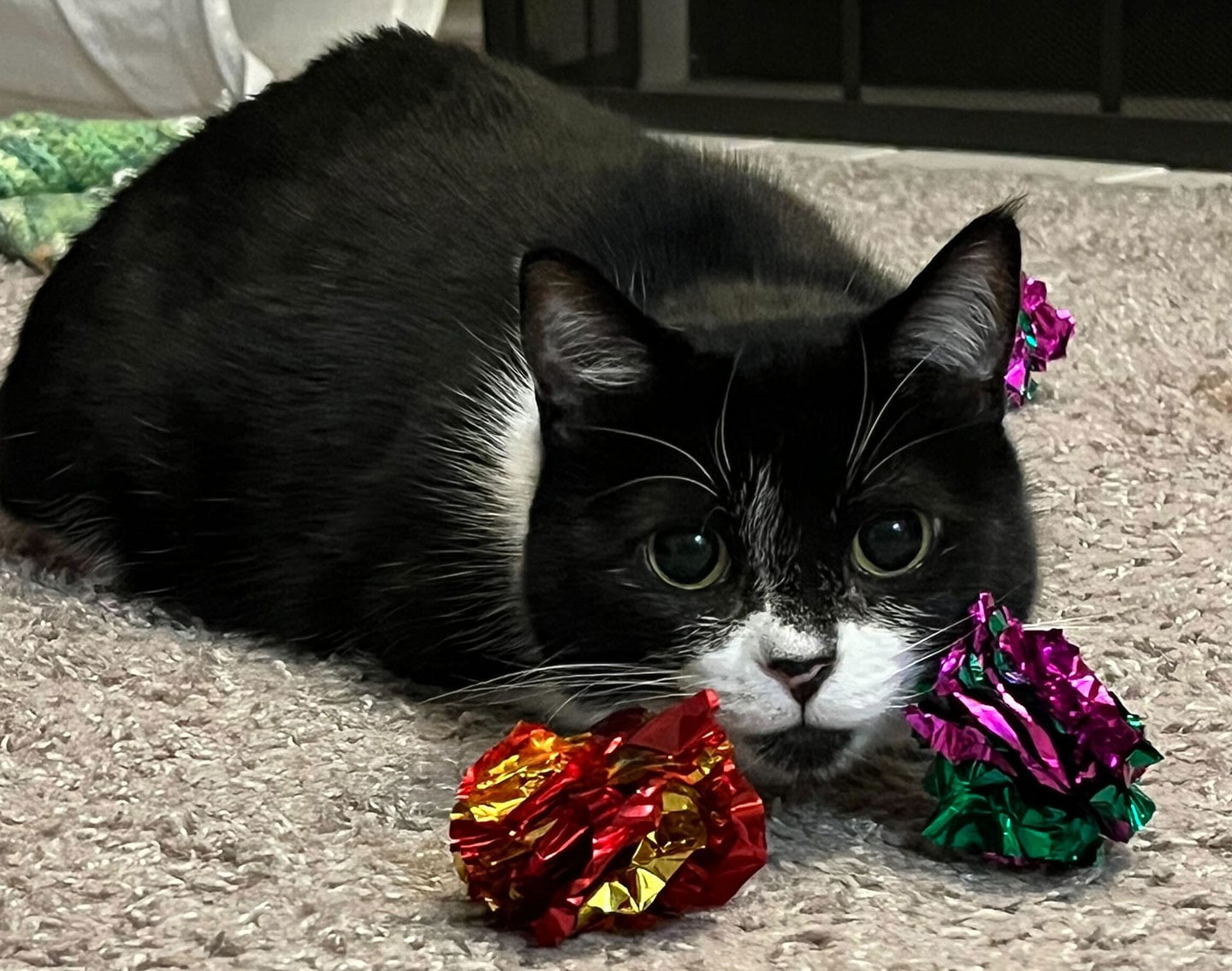
John Wick poses with this new favorite cat ball toys from SunGrow. Photo courtesy of Claudia Guthrie.
- Stephanie Brown: Brown is a Chewy editor who has been writing and editing content on a wide array of cat topics for over 10 years. She tested cat toys with her 7-year-old sassy tortie, Luna.
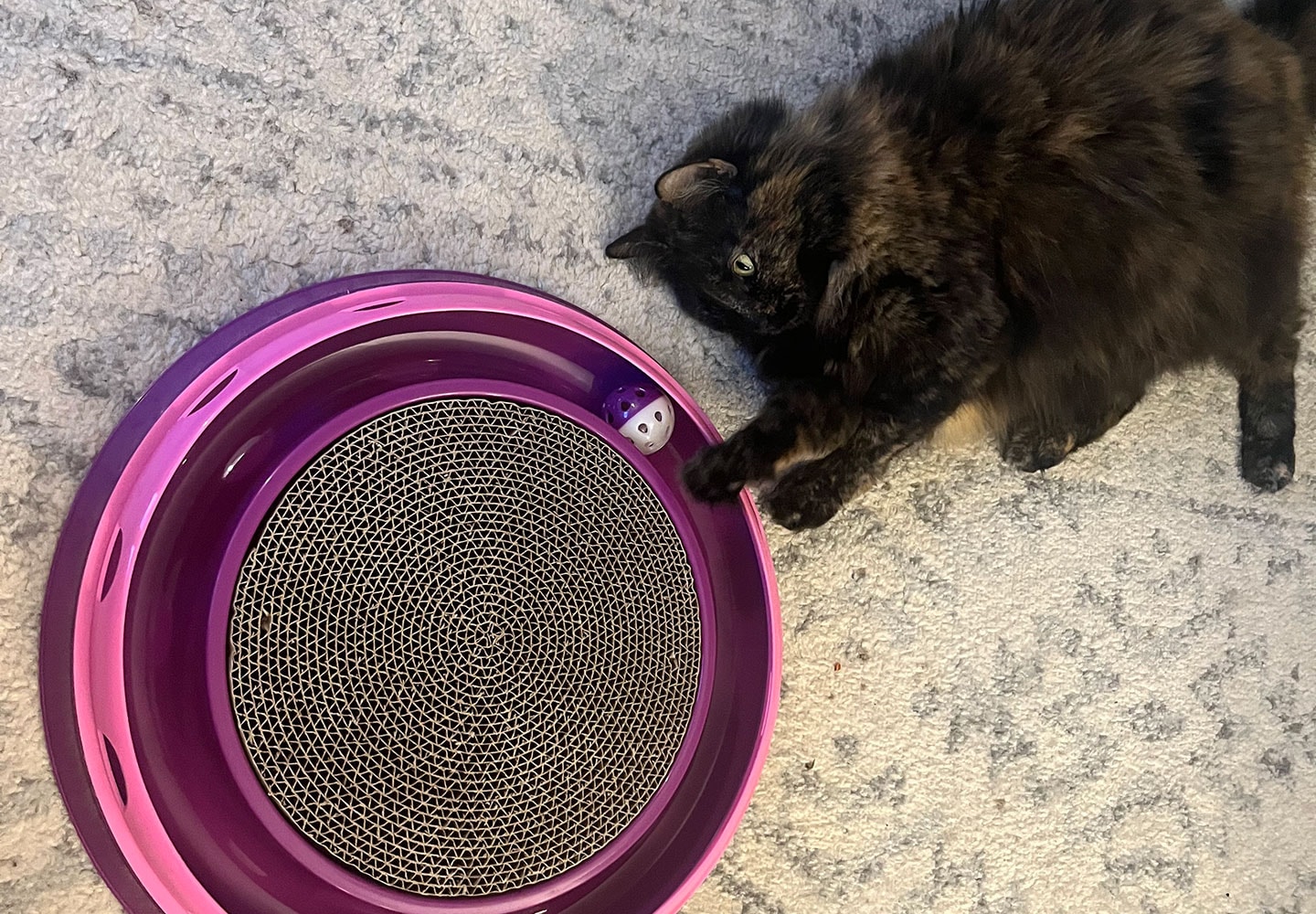
Luna keeps her eye on the ball inside the Frisco Scratch & Roll cat toy. Photo courtesy of Stephanie Brown.
Buying Guide: Types of Cat Toys
Interactive Cat Toys
Dr. Mitchell defines these toys as those that require interaction between the human, the toy, and the cat. Examples include wand toys and laser pointers (more on both of those below).
“You’re on one end of the teaser wand and the cat on the other end with the toy in the middle, as opposed to those little mice you can sit on the ground and the cat chases the mice, and you’re not involved anymore,” she says.
Teaser Toys/Wands
These are long wands with a dangly object of some sort on the end. The object is typically a plush toy, feathers, or a ribbon. As an interactive toy, they require pet parent interaction, specifically waving it around for the cat to catch.
Dr. Mitchell advises pet parents to exercise caution when playing with these toys, and to only let cats play with them under supervision. The strings could become twisted around limbs, or the toy can get caught in their teeth. If you play too rough, especially after they’ve caught it, you could inadvertently cause an injury.
“It’s not a dog tug-of-war toy. It’s not meant to be ripped out of their mouths,” she says.
Play with it until the cat catches it, then let the cat have it.
“The idea is to mimic a bird that’s flying, and then as soon as the cat catches it, the bird drops dead,” she says. “It’s not meant for you to continue fighting it, like you’ve got a fish on the end of the line.”
Cat Laser Toys
Many cats love to chase the little red dot of a laser pointer. Some are the traditional laser pointer styles, like the Litterbox.com laser we’re recommending, and some are automated, moving on their own.
The key to having your cat play with laser pointer is to not overdo it and to mimic the actions a cat takes when hunting.
“Leave it very still for a while and let the cat kind of beat in on it, then make it run across the floor,” Dr. Mitchell explains.
And always let them “catch” it occasionally.
“If [the cat] never catches it, then what’s the point of the game?” she says.
Never shine it directly into their eyes.
Cat Ball Toys
Ball toys come in a variety of materials and textures. They can be crinkly or made of hard plastic, maybe with bells in them, or soft and plush. Some even have feathers on them.
Dr. Mitchell categorizes these into two main types:
- More solid balls, which easily roll across the floor and are good for swatting
- Balls made of a softer material, which are better for playing fetch because they’re easier to carry
“I find that the cats that like the ping-pong ball types aren’t necessarily fetchers and vice versa, so it takes trying a few different ball styles to figure it out,” she says.
Cat Plush Toys
Plush toys for cats come in all shapes and sizes, from mice and other wild animals to bananas and ice cream cones.
Cats may cuddle against these or drag them around the house. If the stuffed toy is small enough, you could toss it and use it for playing fetch. They also make great toys to wrestle with.
Dr. Mitchells says the ones that are infused with catnip or that crinkle are probably more likely to excite your cat—and take the brunt of bunny kicks.
In fact, there are specific types of plush toys that a meant to be kicked. These so-called kicker toys are designed so cats can grab onto them with their front paws and “bunny kick” them with their hind legs.
Cat Puzzle Toys
Puzzles toys usually require the cat to move the toy or parts of the toy around to reveal a treat.
These can be board games where cats have to slide or otherwise move game pieces to uncover the treats. These can also be treat-dispensing toys, like a ball that you fill with treats or kibble, and the cat has to roll the ball around to get a treat to come out.
Puzzle toys engage cat’s hunting instincts while also engaging their mind by having them solve the problem at hand: How do I get this food?
“In the wild, they have to figure out how to get their food every day,” Dr. Mitchell says. “Again, it mimics a more natural behavior.”
Another benefit of a puzzle toy is that it helps the cat burn calories, especially if they’re chasing down a treat-dispensing toy.
“I think it’s a win/win all the way around,” says Dr. Mitchell.
Cat Chew Toys
Cat chew toys are either stuffed toys, usually with a mesh overlay, or rubber toys that cats can chew on. They’re typically marketed as promoting dental health by helping to keep cat’s teeth clean.
Dr. Mitchell says to be cautious of any items that could become loose during chewing and present a choking hazard.
“If they’re chewing on something that’s got netting or something that’s rubber, we always worry about foreign body ingestion,” she says.
Electronic Toys
Electronic toys are toys that move with help from a power source, like batteries. Some are rechargeable with a USB charger. When turned on, they run for a pre-determined period of time; others are motion-sensor activated and only start when moved by you or the cat.
These types of self-play toys help engage your cat in playtime, and are good ways to keep your cat busy when you’re away from home.
Just make sure your cat is comfortable with the automation, Dr. Mitchell says. You don’t want them to get spooked by the sudden movement and end up being afraid of the toy.
Ball Track Toys
These are another form of self-play toys where a ball is locked into a track, like a ring or a little race car-type track, and the cat can push the ball along with their paws. They’re another great toy to help keep your cat busy when you can’t be there to play with them.
Cat Toy FAQs
Q: What toys do cats like the most?
A: The best cat toy depends on your cat and their personal preference.
Some cats may prefer independent play, which typically includes plush toys, kicker toys, balls and ball track toys, tunnels, puzzles, and electronic toys. Others may prefer to interact with you when playing. Toys that encourage this type of interactive playtime include wands, lasers, and balls or push toys for a game of fetch.
You may notice that some toys can be used for both types of play. Finding the best toy for your cat and how to play with said toy will require some trial and error.
Q: Should you have multiple types of toys for your cat?
A: Yes, you should offer your cat a variety of toys. You never know what style of play is going to strike a cat’s fancy on any given day. Having different types of toys allows them to engage in a variety of play styles.
Even having multiple of the same type of toy is beneficial because you can rotate them, ensuring there is always something “new” that you can swap in to pique their interest.
“The more the merrier,” Dr. Mitchell says.
Q: How can I keep my cat entertained?
A: In addition to cat toys, clicker training, providing access to windows that your cat can look out of (a window perch could help here), and playing cat-approved nature shows or music are all ways to keep your cat entertained.
Looking for even more cat toys? If you’re a Swiftie, you’ll love these cats toys and other cat products that match every Taylor Swift Era.
Read more about cat playtime:
Share:
